
|
For Dee,
Information, known and hitherto unknown about Nibiru.
Nibiru, also known as Marduk,
12th planet or Planet X, first came into the Earth's solar system
far back
before recorded history -- even before the formation of the Earth
itself. If truth were to be
known (and
it will be) the formation of the Earth as it is today is due to
the influence of this occasional interloper to
this solar
system.
How did Nibiru first come into
this system? Though it is commonly
believed and indicated in some of
the ancient writings that it was a natural
part of this system that merely has a very long orbital path,
(more than
3600 years). In fact it was
brought into this system by a group of beings who prided
themselves, albeit
arrogantly, to be the "creators and farmers of life in the
universe." These people,
who
later told humans to call them Annuniki, were at the time a race with great
power of and
supernatural means.
They were not physical in the sense that humans
understand. Though they exist
in this physical dimension, they do not have what could be truly called a
physical form. Surely not the
same as your body is. They were
also a people with far too much self-importance and each of their
accomplishments
fed their skewed pride until such a time as they decided to create a whole
living
planet by themselves.
This solar system was the place
where they choose to attempt their grand
folly. The star was constant
and established and the magnetic forces of the other gas giants, (Jupiter
and Saturn) would make for
a stable area between them and the sun where life
could take hold, if there was a planet in place.
At the time, there were the outer
planets of the Sol system. The
inner planets had not evolved past
bare rocks or molten asteroids yet and
there was no life, as humans generally understand life, in this
system. The Annuniki believed
if they could create a planet, or bring one into the system, then they
could
put it into place and then create life on
it. To them, with all their
successes and with all their
pride, it was an ultimate challenge they could
not resist.
In an attempt to create an
inhabitable planet in the Sol system, they attempted to navigate a planetary
mass that they felt had the potential to bear life into the Sol
system. They did this with a
mixture of
technology and supernatural powers they
possessed. They started with
a moon from the other planet
Neptune. Slowly they moved
it towards the center of the solar system.
Unfortunately, they underestimated
the gradational pull of Uranus, and the moon crashed into Uranus
with such
force that it not only created a phenomenally huge crater on the face of
the planet, but the
force was sufficient to knock Uranus off its axis, and
to this day it rotates on its side, perpendicular to
all other planets in
the system.
This first attempt was scrapped
and another moon was chosen. This
time in order to counter the pull
of Uranus and any pull from other planets,
the next moon chosen was mostly ice so its density could
be controlled by
melting water as needed. Also
it was made to spin opposite of the rest of the natural
turn of the planets
in the Sol system, moreover, it was moved into the solar system in an orbit
contrary
to the rest of the system.
With the new spin, ice and orbit
along with the lessons learned from the first failed attempt, this
moon was
slowly but surely navigated past the gas giants and into the inner area of
the solar system.
Once they passed the last
of the gas giants, they believed they were sure there was no way they could
fail. They concluded that in
order to be "gods" to their soon to be creations, they would need to be
close
to their new creation. So, in
their arrogance, almost all of them, enmasse, decided to transfer
their
consciousnesses to the new moon, which they dared to call Nibiru "Giver of
life".
Since they were not physical
in the sense that they needed to have physical sustenance and provisions,
they were happy enough to live on this barren, ice covered
world. But once again their
superciliousness
nature caused them
grief. No one believed that
they could make such a small mistake of numbers,
and before they knew it,
their beloved Nibiru was on a collision course with a dead rock of a planet
revolving around the sun.
There was much debate about how
to avoid the collision, but it was all for
naught. The two heavenly
bodies
collided in a fury.
Because the small rock world
(earth) was rotating with the proper rotation of the center sun, and was
also orbiting in the proper magnetic direction, its gradational pull overpowered
that of the interloping
moon whose rotation and orbit were contrary to the
established norm. When the dust settled, so to
speak, Nibiru was far smaller,
as the material that made it up, particularly the ice, super heated in the
collision and remained with the small rock world. Thus, water came to the
Earth.
The collision caused many things
to happen. The sheer force of
the impact so close to the gravitational
and magnetic center of a solar system
did not simply destroy one object and knock the other off track
as it had
in the outer reaches of the solar system with their first
attempt. The force was so great,
the
gravitational influences so strong, and coupled with the intense psychic
energies the Annuniki were
exerting, the results were
astounding. Nibiru was instantly
thrown into an orbital abnormality that
not only sent it plummeting through
space, but also through dimension.
The Annuniki, along with their
dear creation, Nibiru, were sent on an incredible elliptical journey that
takes them through space, time, dimensions and realities.
Luckily for the Annuniki, they
are beings who can exist in the type of environment created by such a
journey
- that being no heat, sunlight, water
etc. Also, because of their
non-physical status, Annuniki
are very long-lived beings. Their lifespan
is many, many hundred times longer than a human
beings'.
This is a good thing
because with an orbital path as long as they one they are on, it gives them
some
inkling of continuity.
Over time, Nibiru has returned
in its journey around our sun.
Sometimes when it has passed planet
Earth, Annuniki have "jumped off",
if you will, and visited the Earth.
Sometimes they make short
visits while their planet is in the
area. Sometimes they stay for
whole revolutions. Some are here right
now.
The confusing part comes into
play because Nibiru is still traveling through dimensions, time and space
as it rotates around the sun.
Sometimes when it has passed Earth, although it was close by, perhaps
even passing through, it has been in an alternate dimension and was not seen,
felt or even suspected.
The
only proof that it could have been near, would be, if you looked, a jump
in the ideas, technology
or consciousness of man, caused by Annuniki visitors
interactions and inspirations.
Other times, it has come by and
been in this dimension, or one close enough that its bizarre course
through
the solar system cased problems that effected the world in a physical way,
just as any solid
body passing so close would.
The orbit is about 3669
years, but because in other dimensions it can move quicker or slower, this
is
extremely subject to change. In
general it is within 200 years of this
time. Nevertheless, because
it
can make this orbit totally unseen by the earth due to its location in
dimension or realm at the time
of its passing, it will often only be known
by those who can see into these other
dimensions.
This pass will not be in this
dimension. Even though Nibiru
may show up in close dimensions as it
approaches, so that sometimes it can
be seen on photographs, it has been concluded that it will not
be in a position
to show (be seen) or even to cause problems with the earth until it passes
again in
about 7400 years from now.
That said, it must be noted that
when it does get close enough for the next wave of Annuniki to
"jump over"
to the Earth, be sure they will.
And with that will come great change.
I hope this helps clarify some of your questions.
Sincerely yours,
Alex
2008 -
INTERVIEW OF BOB
DEAN ABOUT NIBIRU AND THE ANUNNAKIS
He has a different opinion. Very interesting.
October 21, 2009
Posted by Zechariah Sitchin
|
||
Subj: IUFO: On Planet X, The Tenth Planet: Niburu? (fwd)
Date: 10/21/00 8:16:09 PM Pacific Daylight Time
Astronomy Magazine
Search for the Tenth Planet
Dec-1981
Astronomers are readying telescopes to probe the outer reaches of our solar
system for an elusive planet much larger than Earth. Its existence would
explain a 160-year-old mystery. The pull exerted by its gravity would account
for a wobble in Uranus' orbit that was first detected in 1821 by a French
astronomer, Alexis Bouvard. Beyond Pluto, in the cold, dark regions of space,
may lie an undiscovered tenth planet two to five times the size of Earth.
Astronomers at the U.S. Naval Observatory (USNO) are using a powerful computer
to identify the best target zones, and a telescopic search will follow soon
after. Van Flandern thinks the
tenth planet may have between two and five Earth masses and lie 50 to 100
astronomical units from the Sun. (An astronomical unit is the mean distance
between Earth and the Sun.) His team also presumes that, like Pluto's, the
plane of the undiscovered body's orbit is tilted with respect to that of most
other planets, and that
its path around the Sun is highly elliptical.
New York Times
19-Jun-1982
A pair of American spacecraft may help scientists detect what could be a 10th
planet or a giant object billions of miles away, the national Aeronautics and
Space Administration said Thursday. Scientists at the space agency's Ames
Research Center said the two spacecraft, Pioneer 10 and 11, which are already
farther into
space than any other man-made object, might add to knowledge of a mysterious
object believed to be beyond the solar system's outermost known planets.
The space agency said that persistent irregularities in the orbits of Uranus
and Neptune "suggest some kind of mystery object is really there" with its
distance depending on what it is. If the mystery object is a new planet, it
may lie five billion miles beyond the outer orbital ring of known planets, the
space agency said. If it
is a dark star type of objet, it may be 50 billion miles beyond the known
planets; if it is a black hole, 100 billion miles. A black hole is a
hypothetical body in space, believed to be a collapsed star so condensed that
neither light nor matter can escape from its gravitational field.
Newsweek
Does the Sun Have a Dark Companion?
28-Jun-1982
...When scientists noticed that Uranus wasn't following its predicted orbit
for example, they didn't question their theories. Instead they blamed the
anomalies on an as yet unseen planet and, sure enough, Neptune was discovered
in 1846. Now astronomers are using the same strategy to explain quirks in the
orbits of Uranus and Neptune. According to John Anderson of the Jet Propulsion
Laboratory in Pasadena, Calif., this odd behavior suggests that the sun has an
unseen companion, a dark star gravitationally bound to it but billions of
miles away. Other scientists suggest that the most likely cause of the orbital
snags is a tenth planet 4 to 7 billion miles beyond Neptune. A companion star
would tug the outer planets, not just Uranus and Neptune,
says Thomas Van Flandern of the U.S Naval Observatory. And where he admits a
tenth planet is possible, but argues that it would have to be so big - a least
the size of Uranus - that it should have been discovered by now. To resolve
the question, NASA is staying tuned to Pioneer 10 and 11, the planetary probes
that are
flying through the dim reaches of the solar system on opposite sides of the
sun.
New York Times
30-Jan-1983
Something out there beyond the farthest reaches of the known solar system
seems to be tugging at Uranus and Neptune. Some gravitational force keeps
perturbing the two giant planets, causing irregularities in their orbits. The
force suggests a presence far away and unseen, a large object that may be the
long- sought
Planet X. The last time a serious search of the skies was made it led to the
discovery in 1930 of Pluto, the ninth planet. But the story begins more than a
century before that, after the discovery of Uranus in 1781 by the English
astronomer and musician William Herschel. Until then, the planetary system
seemed to end with
Saturn.
As astronomers observed Uranus, noting irregularities in its orbital path,
many speculated that they were witnessing the gravitational pull of an unknown
planet. So began the first planetary search based on astronomers predictions,
which ended in the 1840's with the discovery of Neptune almost simultaneously
by English, French, and German astronomers. But Neptune was not massive enough
to account entirely for the orbital behavior of Uranus. Indeed, Neptune itself
seemed to be affected by a still more remote planet.
In the last 19th century, two American astronomers, Willian H. Pickering and
Percival Lowell, predicted the size and approximate location of the
trans-Neptunian body, which Lowell called Planet X. Years later, Pluto was
detected by Clyde W. Tombaugh working at Lowell Observatory in Arizona.
Several astronomers, however, suspected it might not be the Planet X of
prediction. Subsequent observation proved them right. Pluto was too small to
change the orbits of Uranus and Neptune, the combined mass of Pluto and its
recently discovered satellite, Charon, is only 1/5 that of Earth's moon.
Recent calculations by the United States Naval Observatory have confirmed the
orbital perturbation exhibited by Uranus and Neptune, which Dr. Thomas C Van
Flandern, an astronomer at the observatory, says could be explained by "a
single undiscovered planet". He and a colleague, Dr. Richard Harrington,
calculate that
the 10th planet should be two to five times more massive than Earth and have a
highly elliptical orbit that takes it some 5 billion miles beyond that of
Pluto - hardly next-door but still within the gravitational influence of the
Sun.
Washington Post
Mystery Heavenly Body Discovered, a front page story
31-Dec-1983
A heavenly body possibly as large as the giant planet Jupiter and possibly so
close to Earth that it would be part of this solar system has been found in
the direction of the constellation Orion by an orbiting telescope aboard the
U.S. infrared astronomical satellite. So mysterious is the object that
astronomers do not know if it is a planet, a giant comet, a nearby "protostar"
that never got hot enough to become a star, a distant galaxy so young that it
is still in the process of forming its first stars or a galaxy so shrouded in
dust that none of the light cast by its stars ever gets through. "All I can
tell you is that we don't know what it is," Dr. Gerry
Neugebauer, IRAS chief scientist for California's Jet Propulsion Laboratory
and director of the Palomar Observatory for the California Institute of
Technology said in an interview.
The most fascinating explanation of this mystery body, which is so cold it
casts no light and has never been seen by optical telescopes on Earth or in
space, is that it is a giant gaseous planet, as large as Jupiter and as close
to Earth as 50 billion miles. While that may seem like a great distance in
earthbound terms, it is a stone's
throw in cosmological terms, so close in fact that it would be the nearest
heavenly body to Earth beyond the outermost planet Pluto. "If it is really
that close, it would be a part of our solar system," said Dr. James Houck of
Cornell University's Center for Radio Physics and Space Research and a member
of the IRAS science team. "If it is that close, I don't know how the world's
planetary scientists would even begin to classify it."
The mystery body was seen twice by the infrared satellite as it scanned the
northern sky from last January to November, when the satellite ran out of the
supercold helium that allowed its telescope to see the coldest bodies in the
heavens. The second observation took place six months after the first and
suggested the
mystery body had not moved from its spot in the sky near the western edge of
the constellation Orion in that time. "This suggests it's not a comet because
a comet would not be as large as the one we've observed and a comet would
probably have moved," Houck said. "A planet may have moved if it were as close
as 50 billion miles but it could still be a more distant planet and not have
moved in six months time.
Whatever it is, Houck said, the mystery body is so cold its temperature is no
more than 40 degrees above "absolute" zero, which is 459 degrees Fahrenheit
below zero. The telescope aboard IRAS is cooled so low and is so sensitive it
can "see" objects in the heavens that are only 20 degrees above absolute zero.
When IRAS
scientists first saw the mystery body and calculated that it could be as close
as 50 billion miles, there was some speculation that it might be moving toward
Earth. "It's not incoming mail," Cal Tech's Neugebauer said. "I want to douse
that idea with as much cold water as I can."
US News World Report
Planet X - Is It Really Out There?
10-Sept-1984
Shrouded from the sun's light, mysteriously tugging at the orbits of Uranus
and Neptune, is an unseen force that astronomers suspect may be Planet X - a
10th resident of the Earth's celestial neighborhood. Last year, the infrared
astronomical satellite (IRAS), circling in a polar orbit 560 miles from the
Earth, detected heat from an object about 50 billion miles away that is now
the subject of intense speculation. "All I can say is that we don't know what
it is yet," says Gerry Neugesbeuer, director of the Palomar Observatory for
the California Institute of Technology. Scientists are hopeful that the
one-way journeys of the Pioneer 10 and 11 space probes may help to locate the
nameless body."
Washington Post: Mystery Heavenly Body Discovered, a front page story
31-Dec-1983
A heavenly body possibly as large as the giant planet Jupiter and possibly so close to Earth that it would be part of this solar system has been found in the direction of the constellation Orion by an orbiting telescope aboard the U.S. infrared astronomical satellite. So mysterious is the object that astronomers do not know if it is a planet, a giant comet, a nearby "protostar" that never got hot enough to become a star, a distant galaxy so young that it is still in the process of forming its first stars or a galaxy so shrouded in dust that none of the light cast by its stars ever gets through. "All I can tell you is that we don't know what it is," Dr. Gerry Neugebauer, IRAS chief scientist for California's Jet Propulsion Laboratory and director of the Palomar Observatory for the California Institute of Technology said in an interview.
The most fascinating explanation of this mystery body, which is so cold it casts no light and has never been seen by optical telescopes on Earth or in space, is that it is a giant gaseous planet, as large as Jupiter and as close to Earth as 50 billion miles. While that may seem like a great distance in earthbound terms, it is a stone's throw in cosmological terms, so close in fact that it would be the nearest heavenly body to Earth beyond the outermost planet Pluto. "If it is really that close, it would be a part of our solar system," said Dr. James Houck of Cornell University's Center for Radio Physics and Space Research and a member of the IRAS science team. "If it is that close, I don't know how the world's planetary scientists would even begin to classify it."
The mystery body was seen twice by the infrared satellite as it scanned the northern sky from last January to November, when the satellite ran out of the supercold helium that allowed its telescope to see the coldest bodies in the heavens. The second observation took place six months after the first and suggested the mystery body had not moved from its spot in the sky near the western edge of the constellation Orion in that time. "This suggests it's not a comet because a comet would not be as large as the one we've observed and a comet would probably have moved," Houck said. "A planet may have moved if it were as close as 50 billion miles but it could still be a more distant planet and not have moved in six months time.
Whatever it is, Houck said, the mystery body is so cold its temperature is no more than 40 degrees above "absolute" zero, which is 459 degrees Fahrenheit below zero. The telescope aboard IRAS is cooled so low and is so sensitive it can "see" objects in the heavens that are only 20 degrees above absolute zero. When IRAS scientists first saw the mystery body and calculated that it could be as close as 50 billion miles, there was some speculation that it might be moving toward Earth. "It's not incoming mail," Cal Tech's Neugebauer said. "I want to douse that idea with as much cold water as I can."
Origins of the rings of Uranus and Neptune 1. Statistics of satellite disruptions
Joshua E. Colwell
Laboratory for Atmospheric and Space Physics, University of Colorado, Boulder
Larry W. Esposito
Laboratory for Atmospheric and Space Physics, University of Colorado, Boulder
Abstract
Stochastic simulations of the collisional fragmentation of the small moons
of Neptune and Uranus confirm
the conclusions of Smith et al. [1986, 1989]
that many of these moons cannot have survived intact since the
end of planetary
formation. We perform two types of stochastic simulations of the collisonal
history of small
moons. Monte Carlo simulations in which only the largest
surviving fragment from each disruption is
followed show bimodal probability
distributions for the size of the largest fragment. Once the moon is
destroyed
the first time, the collisional cascade to smaller sizes proceeds relatively
quickly. A Markov chain
approach allows us to follow the size distribution
from each disruption to arbitrarily small sizes. These
simulations show that
the more numerous smaller fragments can outlive the largest fragment followed
in
the Monte Carlo formalism. We find that the evolution of moon populations
from catastrophic fragmentation
is more complex than can be described by
a simple break-up ‘‘time scale.’’ We rederive cratering
rates using
the method of Smith et al. [1986, 1989] for all the satellites
of Uranus and Neptune with an improved crater
scaling and modified impactor
distributions.These changes produced a higher number of predicted craters
larger than the radii of the small moons of Uranus and Neptune than derived
by Smith et al. [1986, 1989].
Our more detailed simulations of the catastrophic
fragmentation process also show a higher rate of
disruptions than estimated
by Smith et al. [1986, 1989]. The smallest observed moons at Uranus and
Neptune
have calculated lifetimes against catastrophic fragmentation of less than
5×108 years. If we
require that half the mass of a satellite is given
escape velocity we find lifetimes for Cordelia (1986U7),
Naiad (1989N6),
and Thalassa (1989N5) of 9×108, 2×109, and 4×109 years,
respectively. We conclude that
we are observing a collisionally evolved small
satellite population around Neptune and Uranus and that
some observed moons
are gravitationally bound rubble piles that have undergone multiple disruptions.
In order for the satellites to be primordial the population of planet family
comets in the outer solar system
would have to be smaller than current estimates
by at least a factor of 5.
Index Terms:
Citation:Colwell, Joshua E., L. Esposito, Origins of the rings of Uranus
and Neptune 1. Statistics of satellite disruptions, J.
Geophys. Res., 97(E6),
10227-10241, 1992.
FROM: http://www.agu.org/pubs/crossref/test/1992/92JE00788.shtml
Uranus was discovered in 1781 by William Herschel. Herschel was doing
a survey of bright stars looking for
evidence of stellar parallax. He didn't
find any parallaxes (the first parallax measured for any star was about
50
years after this). But he *DID* discover a faint, blue resolved object. It
was not a star, and Herschel was
a good enough observer to realize it was
not a star. It was a new planet.
It is a cautionary tale to note that there are at least 17 surviving examples
of star charts made by astronomers
before 1781 that show Uranus on them.
But in each case, it was mis-identified as a blue star.
Uranus is about four times the radius of Earth, and about 15 times the
mass of Earth. It is so far from the Sun
that its orbital period is about
84 years. But the most remarkable gross physical property of Uranus is that
it
is tipped over on its side. The inclination of its rotational axis to
its orbital plane is about 98 degress
(compared to 23.5 degrees for the Earth).
This means that for about a quarter of each orbit a given pole is
pointing
more or less straight at the Sun. So Uranus probably has some pretty peculiar
seasons.
Why is Uranus tipped over on its side? We don't really know, of course.
But the currently favored answer
(this shouldn't surprize you, if you've
been paying attention) is that something really big slammed into it a
long
time ago. In this case "really big" means something about Earth-sized.
Atmosphere
That atmosphere of Uranus is similar to that of both Jupiter and Saturn:
80% H2
15% He
5% in H2O, CH4, NH3 and traces of other stuff
Like the other Jovian planets, the density of the atmosphere increases with depth until it liquifies.
Unlike Jupiter and Saturn, there is no obvious cloud structure to the
atmosphere of Uranus. This is because
the atmosphere is simply too cold for
the sort of strong turbulence that causes the cloud structure we see
on Jupiter
and Saturn. But there is a belt/zone circulation pattern that becomes apparent
when the Voyager
images are heavily color-enhanced. And there is even some
weak evidence for clouds. The cloud is that
small streak at about 1 to 2
o'clock.
The fact that the belt/zone circulation pattern exists at all on Uranus
is very interesting. Because it means
that the primary driver of this sort
of circulation is the planetary rotation rather than the nature of the Solar
heating. This must be so because of the strong tilt of Uranus's rotation
axis.
INTERIOR
The interior of Uranus is a bit more complicated than that of Jupiter
or Saturn. The density is considerably
higher (about 1.3 g/cc on average).
The mass is much lower, so the central density must be lower. This only
makes
sense if the composition of Uranus includes a much higher fraction of heavy elements than that of
Saturn or Jupiter.
There is an outer layer of liquid H2 and He. Inside this, there is a mantle
that is a mixture of volatiles ("icy
material") and refractory elements (rocky
material). And there is a solid core of heavy elements (rocky
material plus
iron). The core is solid, and the internal pressure is nowhere high enough
to produce
liquid metallic H2.
One of the really big surprizes of the Voyager 2 fly-by was that, despite
this, Uranus has a substantial
magnetic field (about 0.75 the strength of
Earth's). And the really odd thing is that the magnetic field axis
does not
go through the center of the planet. It is both tilted (by about 60 degrees),
and off-set (by about
0.3 planetary radii).
Now, one reason humans put these remote planetary probes out there is
to surprise ourselves. And it
sure worked this time. But about 15 years have
passed since the Voyager 2 fly-by, and we've had a
chance to puzzle this
one out. The solution appears to be that the magnetic field isn't generated
in the
core. It's generated by liquid (and conductive -- don't use an electric
razor in the bathtub!) H2O and NH3
in the mantle. That's why the field axis
is offset.
Because there is a magnetic field, it turns out we can see evidence for
aurorae in the Sun-facing polar
regions. The magnetic field also allowed
us to measure a good rotation period for Uranus (given the
lack of visible
atmospheric structure, the faintness of the planet, and the fact that it's
been nearly pole-
on to us for the last 30 years made that difficult to do
otherwise). The rotation period ois about 17.25
hours. This fits in well
with the observe oblateness, and composition.
Evolution of Uranus
Uranus has a far lower fraction of its mass in H2 and He than do Saturn
and Jupiter. Thus it must have
formed more slowly than they did. And, given
its place in the Solar System, that much makes sense.
There was less material
in the Solar Nebula that far out in the Solar System, and Uranus moves more
slowly in its orbit. But the problem is models indicate it would form TOO
slowly. That is, if you try to
make a planet that big, that far out in the
Solar Nebula, the Nebula disperses before you have much of
a planet. Now,
we know Uranus is there, so it MUST be possible for it to form. Current models
for its
formation (and that of Neptune as well) argue that it was more likely
to have formed much closer to the
Sun -- somewhere between the orbits of
Jupiter and Saturn, and then got gravitationally scattered out
to its present
orbit by Jupiter.
Ring System
Uranus has a ring system. Like Jupiter's, it is faint and the rings are
narrow. The rings were detected in
1977 by stellar occultation. A bright
star was going to pass behind Uranus. As this star was monitored
before the occulation, its brightness dropped and came back up several times. It was
being partly
occulted by the rings. We couldn't actually image the rings
until the Voyager 2 fly-by. There are ten
known major rings, but like Saturn,
they are actually composed of many ringlets. The ring material is
actually
quite dark. It shows up best when it is back-lit. This indicates the rings
are composed of small
particles. The particles have a very low albedo (about
0.04 - roughly that of soot). They are probably
rock/ice particles in which
the methane ice (CH4) has been photoreduced a amorphous carbon (that is,
soot) by Solar UV radiation.
It is impossible for the rings to be stable structures in and of themselves.
Something must be maintaining
them unless we got very lucky to catch them
before they dissipated. And we think we know what maintains
them. Shepherd
moons. These are small satellites in orbits that cause them to pull material
into orbits
between them, and stabilize that material. We see them in some
cases. We just suspect they must be
there in others.
Satellite System
There are 5 large moons, and at last count 16 tiny ones (including several
Shepherd Moons). The five
large ones (all known before the Voyager 2 fly-by
are named after sprites from The Tempest:
Oberon
Titania
Umbriel
Ariel
Miranda
The other tiny moons are very dark, much like the ring particles. The
interpretation is the same - that the
surfaces of the the small moons are
coated with amorphous carbon from the photoreduction of methane.
The five large moons are all differentiated bodies, with rocky interiors
and icy mantles. Oberon and
Umbriel are both dark, and heavily cratered.
Titania is of interest because, even though it is heavily
cratered, it has
no large craters. This would seem to imply that it was resurfaced just after
the phase
of really heavy bombardment. Lots of objects have struck it since
then, but no really large ones.
Ariel has a relatively smooth and bright surface. It also has many very
large cracks or channels on its
surface. These all indicate that the surface
is comparatively young. There may be an orbital resonance
at work here that
puts sufficient energy into Ariel that it can be resurfaced periodically.
Miranda is too weird for words. It has been seriously messed with. It
has many seemingly impossible
geologic features. Including the cheveron, a
cliff that is at least 3 miles high, and a stunning collection
of grooves
and cracks. Early interpretations of Miranda focused on the idea that something
smashed it
to rubble soon after it formed, but did not hit it hard enough
to disperse it. Thus it reassembled itself due
to self gravity. A more recent
model is that these features are due to slow surface convection. But we
really
don't understand this one.
FROM:
http://odin.physastro.mnsu.edu/~eskridge/astr102/week13.html

Astronomers have found one of the largest objects ever detected orbiting the Sun.
It was seen in a deep space survey looking for bodies circling our star out near Pluto, the most distant planet. Only planets are larger than this new object, dubbed 2001 KX76.The icy, reddish world is over a thousand kilometres across and astronomers say there may be even larger objects, bigger than planet Pluto itself, awaiting discovery.
"What we have seen may be only the tip of the iceberg," co-discoverer Dr Lawrence Wasserman told BBC News Online.
Big surprise
The world - it is big enough to be called a world - has a typical reddish hue and is probably covered in ice. It orbits the Sun beyond Neptune in the so-called Kuiper Belt - a region that extends far beyond the known planets.
Since 1992, over 400 Kuiper Belt Objects (KBOs) have been detected. Their discovery has revolutionised our view of the distant reaches of our Solar System. It is the sheer size of 2001 KX76 that is exciting astronomers.
"When we spotted it, we just wrote 'wow' on the image," Lawrence Wasserman, of the Lowell Observatory in Arizona, US, said. "We knew right away it was a big one."
Lowell Observatory Director, Robert Millis, added: "This object is intrinsically the brightest Kuiper Belt Object found so far."
"The exact diameter of 2001 KX76 depends on assumptions that astronomers make about how its brightness relates to its size. Traditional assumptions make it the biggest by a significant amount, while others make it larger by at least 5%."
Uncertain orbit
2001 KX76 could be as large as 1,270 km (788 miles) across, bigger than Ceres, the largest known asteroid (an object that orbits the Sun between Mars and Jupiter). It is even larger than Pluto's moon Charon, which has an estimated diameter of 1,200 km (744 miles).
Astronomers estimate that 2001 KX76 is currently at a distance of just over 6.4 billion km (4 billion miles) from the Sun. Its orbit is inclined by approximately 20 degrees with respect to the major planets, but the detailed shape of its orbit remains uncertain.
Available evidence suggests that the newly discovered KBO may be in an orbital dance with Neptune, orbiting the Sun three times for each time that Neptune completes four orbits.
"2001 KX76 is so exciting because it demonstrates that significant bodies remain to be discovered in the Kuiper Belt," Robert Millis explains.
True extent
Lawrence Wasserman agrees: "We have every reason to believe that objects ranging up to planets as large or larger than Pluto are out there waiting to be found."
Dr David Jewitt of the University of Hawaii who has discovered many KBOs, including the first one ever seen, told BBC News Online: "We're inching up to Pluto. It is just a matter of time until we see Pluto 2, Pluto 3, and so on."
Robert Millis said: "Until the Kuiper Belt has been thoroughly explored, we cannot pretend to know the extent or the content of the Solar System."
The researchers hope that other astronomers who have access to large telescopes over the next few weeks will be able to turn them on 2001 KX76 in the hope of gathering enough light to get a spectrum of the object.
|
|||||||||||||||||||||||||||||||
ERIS?
FROM: http://www.australia.to/story/0,25197,23040466-937,00,00.html
The real cause of climate
changes, volcanoes activity, intensification of the seismic
activity etc., is the
planet Eris’s getting closer to our solar system, intermediary
named 2003 – UB – 313, and known in
Antiquity under various names as: Nibiru, Marduk, Nemesis, |
Hercolubus, the Gods Planet, the Planet
of the Empire, the Planet of the Cross or the Red Planet.
Below is a short record of the first (recent) contacts with Eris:
First observed on October
21, 2003 using the 1.22 Oschin telescope, at Mount Palomar
Observatory
( California ).
Discovered by Michael E.
Brown, Chad Trujillo, David L. Rabinovitz, on January 5, 2005,
based on the photos
taken at the above mentioned date.
Furter observations published in October 2005 have shown a satellite named Dysnomia (Gabriel).
The planet Eris/ Nibiru
periodically getting closer to Earth once in 3,600 years generates
numerous climate
changes, one being the global warming with its natural consequence
– the melting of the glaciers. The effect
of glaciers melting, because of their sweet water, will be the
ending of the thermo – saline natural system, the
“ engine “ that allows the Gulfstream circulation to the North and
the freezing of spread areas in the North
– West of Europe and North – East U.S.A.
Briefly, here is the
process that took place during the last two periods in which the
Gods planet has passed
between Mars and Jupiter, the nearest point to Earth:
7,200 years ago, during
the cataclysm known as “Noah’s flood“, “sudden changes in
temperature, violent
storms and water avalanches from Antarctica broke off from their
‘ice prison’ Dr. John T. Hollin at Maine
University (U.S.A.) considers that large pieces periodically came
out of the Antarctic ice field creating a
huge tide” (Zecharia Sitchin, The Twelfth Planet).
3,600 years ago, during
the Jews’ Exodus from Egypt in the middle of the second millennium
B.C., the Earth
suffered big cataclysms. “A celestial body that recently entered
our solar system – a new comet – came very
close to Earth [causing – A/N] the eventual disappearance of the
glacier layer“ (Immanuel Velikovsky,
“Worlds in Collision“).
The current situation – the Poles glaciers’ melting is accelerating .
The climate and geological
changes will increase because the planet Eris/ Nibiru has not even
been close
to Pluto, its nearest point to Earth. This is supposed to happen
between 2012 – 2014.
Nowadays, identical
phenomena (global warming and volcanoes activation) also take
place on other planets
from our solar system because of Eris/ Nibiru. Here are few
examples:
The Neptune’s moon, Triton is warming (BBC Science & Technology News, July 25, 1999).
Pluto experiences an extraordinary heating (Massachusetts Institute of Technology News, October 9, 2002).
Volcanic eruption on Jupiter’s satellite Io (Icarus Astronomy , November 2002).
The warming of Mars (ABC News, December 7, 2002).
The warming of Saturn
(January 28, 2007,
www.interstars.net):
scientist of the UCLA (University of California,
Los Angeles) – physics and astronomy department and those at the
University of Boston have noticed that
the temperature of the superior atmosphere of Saturn is higher
that estimated. Thus, professor Allan Aylward
at UCLA considers necessary the reexamination of the main
hypotheses regarding the planetary atmosphere
and establishing the cause of the respective heating. He also
noticed a similar process on Mars, concluding:
“Studying the aspects within other planetary atmospheres will help
us to find out clues of the Terra’s future“.
The books already
mentioned also include various other description of severe
phenomena as volcanoes
activation, increasing seismic activity, terible hurricanes, huge
tides, Pole reversal, and so on, that happened
7,200 years ago, respectively 3,600 years ago, processes that are
more and more frequent nowadays on Earth.
Here are few additional arguments that Eris is Nibiru:
The number of its
satellites. Zecharia Sitchin said on them in the above – mentioned
work : “Four satellites
[they had a rapid rotation movement,‘swirling like twirls’ , three
other satellites – The Mad Wind , The Twirling
Wind and The Sovereign Wind, using their satellites as ‘assault
chariots’, he (Nibiru – A/N) sent ahead the
winds, the all seven winds ready to fight.“
On Wikipedia, the search
“transneptunian object“ returns other seven celestial bodies,
except Pluto and Eris,
most of them discovered by M. Brown, C. Trujillo, D. Rabinowitz.
Their aproximate dimensions are:
- Eris: 2,400 km
- Santa ( 2003 EL 61 ): 1,800 km
- 2005 Fy 9: 1,800 km
-Sedna: 1,800 km
-Orcus: 1,800 km
- Quaoar: 1,200 km
- Ixion :1,000 km
- Varuna: 1,000 km
The Sumerian writings say
that a satellite of the Nibiru planet hit another planet, Tiamat,
creating the “Sky”
(The Asteroid Belt between Mars and Jupiter) and the Earth in the
beginning of our solar system. Professor
M. Brown has recently proved in the journal Nature that the planet 2003 –
EL 61 suffered a terible collision
with another celestial body at the beginning of our solar system.
More details on
www.futura-sciences.com
(March 28, 2007).
In the following lines I
will highlight the connection between Eris (its intermediary name
was 2003 UB – 313)
and the Antiquity writings, where the planet was frequently named
Nibiru:
In 2003, the year it was
first observed (official comunication), the “Science et Vie“
magazine (the February issue)
presented the elliptical trajectory of another planet in our solar system,
IDENTICAL, with the trajectory of the
Nibiru/ Marduk planet previously presented by Z. Sitchin.
(PHOTO 1 –
www.science-et-vie.com)
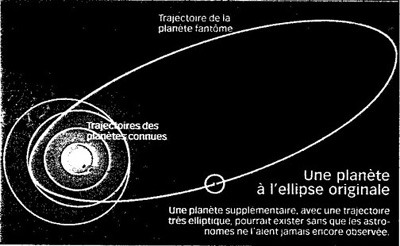
(PHOTO 2 -
www.sitchin.com
)
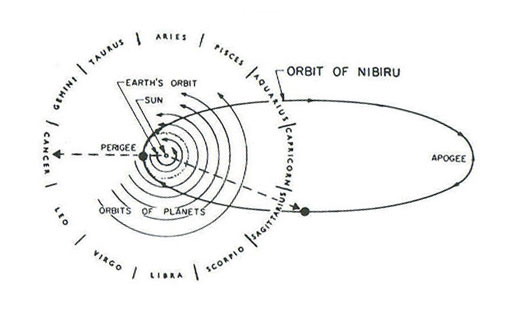
In 2005, several mounths
after being discovered, distinguished astronomers from 19
countries reunited at
the Vatican Astronomical Center connected through the Internet
with Astronomical Centre on the Mount
Tucson (Arizona, USA) – one of the most powerful in the world.
On August 1, 2005
newspapers from around the world wrote: “The celestial body was
given the temporary
name 2003 – UB – 313“. Scientists that gave this name to the
Nibiru planet were very much aware of the
Sumerian writings, as “UB“ meant the seven planets group (3 + 1 +
3 = 313 = 7) consisting of Mars, Jupiter,
Saturn, Uranus, Neptune, Pluto and Nibiru. The other group
consists of the five remaining planets
(2 + 0 + 0 + 3 = 2003 = 5), meaning: the Sun, Mercury, Venus the
Earth and the Moon. Neiter “12“ was a
coincidence – the total of the numbers in the intermediary name.
The Sumerians knew 12 celestial bodies!
The same way Z. Sitchin wrote in his book The Twelfth Planet that
the “UB is formed of seven parts, called
giparu in the Acadian language (the night shelter) […] There is no
doubt that is the origin of the ancients’
faith in the ‘seven skies’“.
Eris‘s area, 2,400 km +/-
97 km, measured by using images from the Hubble telescope, was
made public
at the end of April 2006.
In my book titled The
Bible and the UFOs, 1991, based on the data from the Apocalypse/
Revelation, I
had given the dimensions of a possible planetary station: it was
2,400 km.
The last book of the Bible
contains details on the Eris planet (chapter 21: 2,12,16) called
the NEW
JERUSALEM (ERIS/ SALEM), togheter with its diameter and area:
a) diameter: 12,000 x 200 m ( 1 stadium ) = 2,400 km.
b) area: 2,400 km (length) x 2,400 km (width) x 12 (levels or floors) = 69,120,000 km2.
The ancient writings also
stated the comet – like aspect (comet provoking great disasters)
of Eris/
Nibiru, most probably caused by one of its satellites:
a) The Sumerian writings,
7,200 years ago: “A planet moving very fast, on a eliptical orbit,
similar to a
comet“ (Z. Sitchin, The Twelfth Planet).
b) His brightness (Yahweh/
Anu – the Leader of the Gods planet - A/N) is like the sunshine, a
burning flame
following His steps“ (Habacuc 3 : 4 – 5).
c) 3,600 years ago: “A
comet […] came very close to Earth in the middle of the second
millenium B.C.“
(I. Velikovsky, Worlds in Collision).
The current situation:
a) Professor M. Brown
(details also on
www.interstars.net,
January 21, 2007) has declared that the planet
2003 – EL – 61 can undergo the attraction of Neptune, transforming
itself into the brightest comet ever seen,
at least 6000 times brighter than the comet Hale Bopp.
b) Eris is expected to
pass between Mars and Jupiter its nearest point to Earth during
2012 – 2014. This is
the main reason why NASA had launched the Dawn spacecraft on 27
September 2007, which will arrive at
its destination, the Asteroid Belt, in 2011.
The logical explanation of
the warming process on Earth and on the other planets in our solar
system
proves to be the one provided by I. Velikovsky, in his book from
1950: “Two celestial bodies have been
attracted one to each other. The inner masses of the Earth were
pushed to the periphery. The Earth, with
its rotation movement disturbed, started to warm“.
Some images presented by
NASA (APOD - Astronomy Picture Of the Day) show us clearly that on
his way
towards Earth, Station Planet Eris/ Nibiru is growing:
(PHOTO 3 – Eris on July
31, 2005 -
www.nasa.gov)
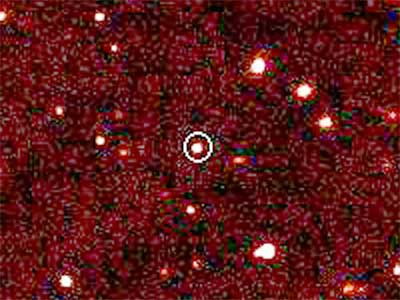
(PHOTO 4 – Eris on August
1, 2005 -
www.nasa.gov)
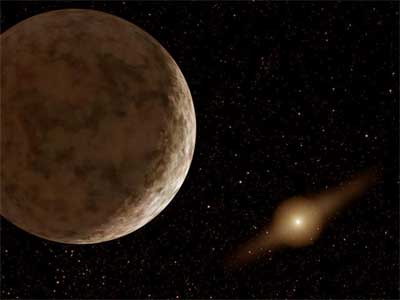
(PHOTO 5 – Eris on
September 18, 2006 -
www.nasa.gov)
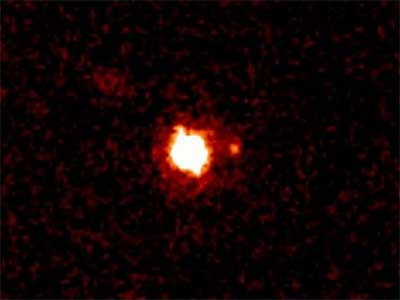
(PHOTO 6 – Eris on June
19, 2007 -
www.nasa.gov)
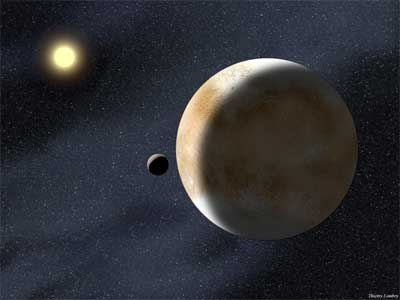
In mass media all over the world, on August16, 2006 appeared the next photo of our solar system:
(PHOTO 7 – the solar
sistem –
www.bbc.co.uk)
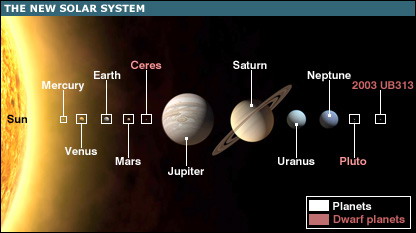
Something was absent: Dark Star. This was present of Andy Lloyd’s website:
(PHOTO 8 – The solar
sistem and the Dark Star –
www.darkstar1.co.uk)
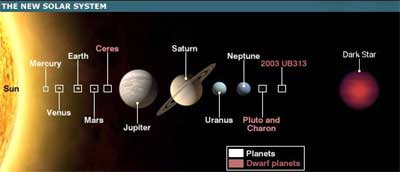
On April 25, 2007 it was
communicated officially the discovery of planet Gliese 581c, which
is possibly to
be like the Earth. This is actually Dark Star, which is orbiting
planet 581.
(PHOTO 9 – May 02, 2007 –
www.nasa.gov)

The photo offered by NASA is almost similar to that from the cover of Andy Lloyd’s book titled Dark Star.
In conclusion, it is
possible to prove the existence of a binary star system in which
the Station/ Planet
Eris/ Nibiru is the physical link or “ ferry “ between our solar
system and the Dark Star system, between
human civilization and Anunnaki/ Elohim civilisation.
I believe that a psychological education of mankind is in full development. Some clues:
1) The Norwegian bunkers –
along with the underground lodgements built in Norway,
(Google.com and YouTube.com: A letter from a Norwegian politician
about 2012) it was also officially
inaugurated a warehouse with hundreds of millions of seeds to
protect humanity in the case of a
catastrophe, on 26 of February, 2008.
The Prime-Minister of
Norway, Jens Stoltenberg, also an ecologist militant, Wangari
Maathai (Kenya) –
the recipient of the Nobel Prize for Peace, Jose Manuel Barroso –
the President of the European
Commission, took part at the inauguration.
(PHOTO 10 –
www.whynotnews.eu)

Two statements from the event:
Jens Stoltenberg: “The
biological diversity is endangered by forces of nature and by
people’s actions; the
bunker with seeds is our insurance policy.” Notice that the
Norwegian Prim-Minister put first “the forces of
nature.”
Jose Manuel Barroso: “We
hope and work for the best, but we must be ready for the worst.”
No further
comments.
2) The bunkers on the
moon. Scientists work at a true “Noah’s Ark” which would be
located under the soil
of the moon. The lodgements should contain information on DNA,
embryos, the melting of metals, plants
growing and all that is essential for life and civilization, if a
catastrophic event would eventually take place
on Earth and threaten the existence of mankind. Details:
Telegraph, The Sun (March 10, 2008).
(PHOTO 11 –
www.telegraph.co.uk)
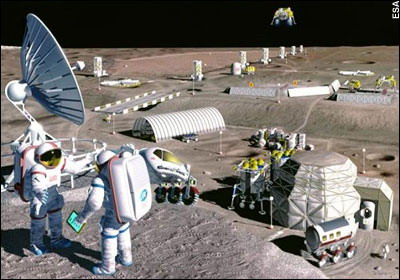
3) In February, 2008, also
came the announcement that Sony Pictures acquired the rights of a
new script
by director Roland Emmerich. The title of the film is “2012” and
will be released in the summer of 2009.
The title “2012” refers to
the date when, according to the Maya calendar, the world as we
know it would end.
Emmerich’s “Apocalypse” is among the movies about disasters, being
similar to the movie “The Day After
Tommorow”, an international success from 2004. The film premiered
in May, 2004, after “The Observer” had
made public a report of Pentagon about the dramatic climatic changes, in
February, 2004 (Google: The
Observer Pentagon Climate).
Notice that starting with
the summer of 2009, the moment of the film’s international
premiere, the planet Eris
/ Nibiru will be seen in the sky as a slightly red object.
4) On the 28 of February,
2008, another news was spread all over the world. Its title was
something like:
“The Japanese astronomers believe in the existance of a new planet
in the solar system.” A few ideas:
The operations were
coordinated by the Japanese professor Tadashi Mukai and by the
American
researcher Patrick Lykawka. They will be published in April, this
year, in the Astronomical Journal
edited by American Society for Astronomy.
“There is a high
probability that a real, still unknown planet… located at the
border of our solar system…
we are now looking in places that we have not looked before, and I think
we will be able to see the planet
within the next five or ten years”, researchers said.
Details on Google: Earth Size Planet News National Geographic;
http://news.nationalgeographic.com/news/2008/03/080317-new-planet.html
The image showed by
National Geographic is IDENTICAL with that showed by NASA in
August 1, 2005:
Planet Eris/ 2003 UB 313.
(PHOTO 13 –
newsnationalgeographic.com)
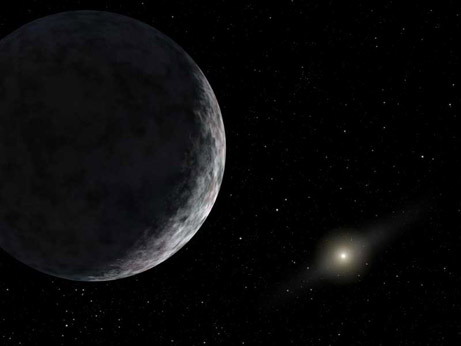
Details in the book “Planet Eris and the Global Warming” (can be found at Amazon).
(PHOTO 14 –
www.amazon.com
)
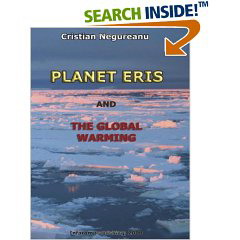
Cristian Negureanu
|
ORBIT JupiterGate |
IS NIBIRU MYTHOLOGY ABOUT A NETWORK OF STARGATES? Maybe Sagan, Contact , was trying to tell us more, tunnels in Middle Cosmos "He (Marduk - the Creator) founded the station of Nibir (Jupiter) to determine their bounds. . ." So many theories. might as well wear them all. Nibiru, Nibiru-station, regardless, Jupiter´s north pole is WEIRD! Could Nibiru be the alternate cosmos, like Valhalla, Amenti, Thule? A place beyond Hamburgerland with entrances here and there like an intergalactic sub-subway? Judaeo/Christian: tunnel-limbo to heaven/hell? Also thinking Clarke's 2010: The Year We Make Contact, cubes, pyramids, spheres, 3D entrances to 4D realms. The Academy of Logos wants us to pick, True/False. The only quiz I´ll take is True/False/Maybe...
|
MYSTERIOUS EMAIL: "You may not realize how right you are. However, brace yourself, the changes are only just beginning. Do not fear however, the "EXPERIMENT" as you call it is not over, it will continue. The only thing remaining to be seen is the way in which you humans handle the coming times. Look to Mars, and the red storm of Jupiter as well. You will be amazed at what you discover."
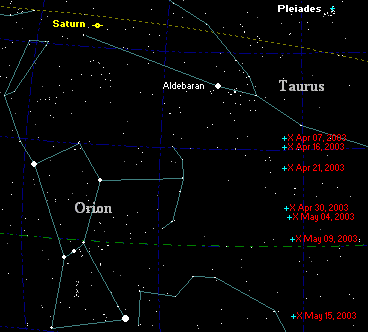
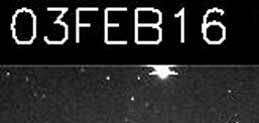

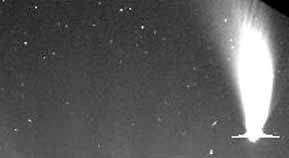
The Sun's New Mysterious Neighbor Astronomers find the closest brown dwarf yet
Did Pluto Take a Punch? January 8, 2003 | If David J. Tholen (University of Hawaii) is right, Pluto was probably hit by a small Kuiper Belt object in the not-too-distant past. One consequence of that collision, he argues, is seen in the planet's motion — Pluto and its satellite Charon now waltz around each other in slightly out-of-round orbits.
Date: 12/17/02 10:15:06 AM Pacific Standard Time
![]() Many NASA
Abstracts concerning Planet X
Many NASA
Abstracts concerning Planet X
FWIW, The NSA has made employees of Nasa and government officials and others to sign an agreement that they cannot divulge information about any catastrophic event that they know about. Military people come under this also. That is why you cannot find "official" documentation of this event. They aren't allowed to tell. These are all Nasa abstracts which are currently not available concerning Planet X. I wonder why??? DETAILS
|
D/1884 O1 (Barnard 1) After this paper was published, only one more observation was reported, by a man who had earlier made a search for the satellite of Venus but failed to find it: on Aug 13 1892, E. E. Barnard recorded a 7th magnitude object near Venus. There is no star in the position recorded by Barnard, and Barnard's eyesight was notoriously excellent. We still don't know what he saw. Was it an asteroid that hadn't been charted? Or was it a short-lived nova that nobody else happened to see? DETECTION OF TRIPLY DEUTERATED AMMONIA IN THE BARNARD 1 CLOUD Hercolubus Hercolubus and the Seven Races Orgonauts 2
|